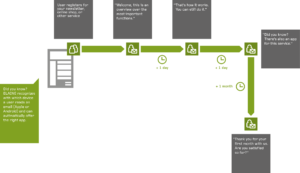A user’s registration to your newsletter, portal or other service is a conscious, proactive process. At that moment, the user is particularly interested in your products and contents and wants more – this is the best time to use his attention and send him a welcome series.
The reasons why a user subscribes to your newsletter can be manifold. In any case, he has a high interest in your products and content. This interest and hence his attention often goes unused. Welcome emails have the task to activate a user directly after his subscription. But you should go even further. Even after receiving the welcome email the user is still highly attentive. He would like to receive information and offers from you and probably does not wish to wait until the next regular newsletter. You should not loose any time since his interest may decrease. Use multi-level automated welcome series to keep the user’s attention on a high level, to learn more about him and retain him.
Choose the right frequency
To keep the user’s attention high, the intervals between the individual emails of the welcome series should not be too long. In any case, the user should still remember the previous email when he receives the next one. As a little refresher, we recommend to briefly refer to the previous email in a short text. There is no general rule for send frequency. However, the intervals should not exceed one week. The best send frequency for welcome series can be found by testing the different frequencies and comparing the open rates. You should avoid sending regular newsletters parallel to the welcome series. Introducing a user step by step to your range, but at the same time presenting the whole range, will be seen as contradictory and confusing by many recipients.
A welcome series should always have the purpose of “familiarising” the user with the regular newsletter. So, please be consistent and bear in mind the following: Design your welcome emails in the same look as the newsletters and use the same sender address. Many companies still send welcome messages from cryptical “no-reply.registrierung@unternehmensname.deaddresses” which seem to have been generated by machines. The aim should be that the user recognises your first regular newsletter immediately as yours. By means of welcome series, open rates of newsletters can be significantly increased. Suggest to the user to add your sender address to his contact list. In this way, you can ensure the deliverability of your emails and prevent an incorrect classification as spam through the spam filter.
Create activity through incentives
By using a welcome series, you introduce prospective buyers to your product and service world. Many users have already learned that they can expect particularly attractive content at the beginning of their dialogue relationship. Don’t disappoint these users by sending them regular offers or promotions which they will later receive in their newsletter, anyway. Instead, focus on incentives: Vouchers, competitions, special offers only for new recipients, product samples, free delivery, exclusive content etc. Furthermore, we would recommend trust-building information such as certificates of quality, customer ratings, special services or customer loyalty programmes. Quite often, users are not even aware of all the aspects of usage or all the benefits. In this case, the user will reward you with a better perception of the service, a stronger retention to your offer and with higher user activity.
Collect further data
The individualisation of content is one of the biggest strengths of email. For this purpose, you need personal data from the user, in order to adjust content precisely to his preferences. This can be socio-demographic data, but also response data such as opens and clicks which can only be collected with the explicit consent from the user.(https://www.elaine.io/en/blog/big-data-right-data/) However, we discourage from asking too many details and comprehensive consent for profiling immediately during the subscription process. This deters many users who “only” wish to subscribe to a newsletter. Instead, use the welcome series to ask the user for more details.
IMPORTANT: Users expect an added value for the disclosure of their data and would like to see content which is tailored to their interests. You should clearly communicate to them how they will benefit from individualised offers. If you already have sufficient data, you can individualise the emails in the welcome series to demonstrate the received added value to the user. The continuation of the series should always conform with the behaviour of the user based on the previous email.
An example
In the example, the user receives emails in a chronological sequence with the thanks for the registration, an overview of the advantages of the service, tips for using it, a reference to the app and a survey on satisfaction after the initial registration. In this way, the welcome message motivates the user to be continuously active, improves knowledge of use and internalises the benefits, and services. With ELAINE, you can create this application with just a few clicks and thus develop users successively and specifically right from the start. Welcome campaigns not only work for new registrations, but also for suitable occasions such as product purchases, service upgrades, or contract renewals.